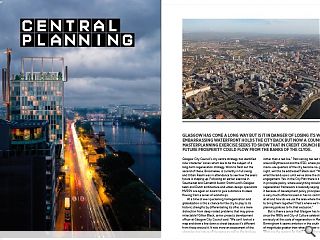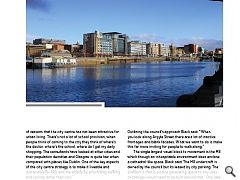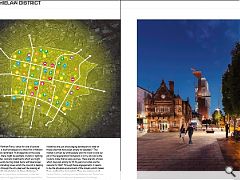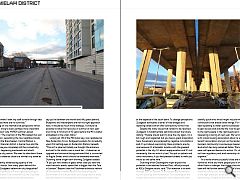Broomielaw District: Central Planning
11 Jan 2017
Glasgow has come a long way but is it in danger of losing its way? An embarrassing waterfront holds the city back but now a council run masterplanning exercise seeks to show that in credit crunch Britain future prosperity could flow from the banks of the Clyde.
Glasgow City Council’s city centre strategy has identified nine ‘character’ zones which are to be the subject of a long-term regeneration strategy. Work to flesh out the second of these, Broomielaw, is currently in full swing and Urban Realm was in attendance to see how the area’s future is shaping up. Following an earlier exercise in Sauchiehall and Garnethill Austin-Smith:Lord’s Glasgow team and Dutch architecture and urban design specialists MVRDV are again on board to give substance to ideas flowing from a series of workshops.At a time of ever quickening homegenisation and globalization is this a chance for the city to play to its historic strengths by differentiating its offer, or a mere distraction from deep rooted problems that may prove intractable? Gillian Black, senior projects development officer at Glasgow City Council said: “We can’t look at a map and draw a line down a street because it’s different from those around it. It was more an assessment of the character and nature of the space as well as the land use, rather than a red line.” Past zoning has led to dead zones around Blythswood and the IFSD, where predominantly mono-use quarters of the city become no-go areas at night, will this be addressed? Black said: “We don’t say what the land-use is until we’ve done the stakeholder engagement. Yes, in the City Plan there is a development in principle policy, where everything should be but the regeneration framework is basically saying, is that right? Is it because of development policy principles that one area is very much office focused or has no commercial activity at all and how do we use the area where they overlap to bring them together? That’s where we’ll introduce planning policies to fix that exclusion.”
But is there a sense that Glasgow has lost momentum since the 1980s and City of Culture celebrations? Looking enviously at the scale of regeneration in Manchester and Birmingham it seems ambition in the south is an order of magnitude greater than what Glasgow is witnessing. What are the reasons for that? “I think there are a variety of reasons that the city centre has not been attractive for urban living. There’s not a lot of school provision, when people think of coming to the city they think of where’s the doctor, where’s the school, where do I get my daily shopping. The consultants have looked at other cities and their population densities and Glasgow is quite low when compared with places like Dublin. One of the key aspects of the city centre strategy is to make it liveable and sustainable for kids and the elderly by prioritizing walking and cycling rather than cars.”
Brownfield land remains one of the greatest hindrances to drawing people down to the waterfront but how can these gap sites be brought back into productive use? Black says: “The ownership structure is fragmented but there are organisations who own good-size plots. Within the regeneration framework what we need to do is look at how we show the potential of an area ranging from cosmetic treatment, which might be lighting or parklets and larger interventions for bigger plots by looking at meantime uses to show the potential of a space.”
The aspiration is for Argyle Street and the Broomielaw to be made ‘pedestrian priority avenues’ although the precise form this will take has yet to be determined. Outlining the council’s approach Black said: “When you look along Argyle Street there are a lot of inactive frontages and blank facades. What we want to do is make this far more inviting for people to walk along.”
The single largest visual block to movement is the M8 which though an inhospitable environment does enclose a cathedral-like space. Black said: The M8 undercroft is owned by the council but its leased by city parking. The problem is that is a noise generating space so any uses or changes would need to be built around that. One idea explored during the Sauchiehall and Garnethill framework was to ‘cap’ the motorway where it enters a cutting. A feasibility study is now underway for that, leading to consideration of how the elevated section is treated. It’s just how that elevation is treated. Ideally it is hoped to encourage people to use Anderston Station to access the riverfront, a route few would choose at present.
Pencilled in for 2019 is there a palpable sense of frustration at the slow pace of change? With land lying idle for decades, a collapsed quay wall at Riverview Gardens and palisade fencing obstructing the path of anyone brave enough to venture along the riverside walkway even basic maintenance and access is being neglected. The Renfrew Ferry, venue for one of several drop-in events, is itself enveloped in a thick film of flotsam and jetsam. Black remarked: “It all depends on the scale of the initiative, there might be parklets, murals or lighting initiatives or other cosmetic treatments which we might be able to do quickly but big ticket items will take longer. These are long standing issues which the council is dealing with and I think through the city deal we’ll be looking at ways to work with stakeholders on these challenges.”
Market forces dictate where investment is directed leading to a chicken and egg dilemma of what comes first is there a case to be made for foregoing further planning initiatives and just encouraging developers to take on these sites that have been empty for decades? “The market is driven by what people want to invest in and our job in the regeneration framework is to try and carve the route to make that an easy journey. There are lots of sites which have sat empty for 10-15 years but what are the reasons for that? Through these engagements, it seems to be the physical environment of the streets which makes them unattractive to investors. They are coming out of Central Station, walking past the Radisson and Robertson Street and see the physical appearance of buildings and streets and concluding this is not a good space or a physical environment I want my staff to walk through late at night - because there are no activities.”
Commenting on the international perspective which his practice can bring to bear, perhaps more important following the Brexit vote, MVRDV partner Jeroen Zuidgeest, said: “The insertion of the M8 created this scar in the urban fabric, separating the two neighbourhoods (Anderston and the Broomielaw). Central Station is barrier one, the financial district is barrier two and the M8 is barrier three you completely kill the connectivity between what’s happening westwards and what’s happening in the city centre. We need to take down these three barriers to create as close to a normal city street as possible.”
Given the frankly embarassing quality of the waterfront as it stands, how many years behind the continent does Zuidgeest believe the city languishes? “It has to do with political will and organizational guts at governmental level. The investment by the City Deal programme is fantastic and we can have fantastic maps and visions but it’s about making it work. I would say you’re between one month and fifty years behind. Blueprints and masterplans are not the right approach here, it should be much more strategic. It should be possible to have first resource in summer of next year and it’ll be a minimum of 10 years before the M8 is better embedded in the urban fabric.”
Looking at J19 of the M8 motorway, now relabeled as New Anderston Cross, Zuidgeest explains his incredulity upon first setting eyes on Anderston Station beneath. “This isn’t a joke but Initially we thought the entrance and exit to the station was a snack bar – it deserves an upgrade and entrance facing eastward that is connected to Argyle Street, which should be extended westward.” Outlining some longer term thinking Zuidgeest added: “If you put two sheets of glass either side you have the most fantastic events space that is bigger than the Tate in London.” Beyond that the Dutchman advises a rethink of the recently installed Fastlink bus lane along the Broomielaw to minimize traffic and doing more to break the asymmetry of development which has seen what regeneration there is focus upon the favoured north bank at the expense of the south bank. To change perceptions Zuidgeest advocates a series of new bridges and repairing streets which offer connectivity to the river.
Despite the many issues that remain to be resolved Zuidgeest is fundamentally optimistic about the future, stating: “People should learn to love the city again, it’s a bit rough and neglected but you have a great proposition here. Developers are paralysed by negative connotations and it’s just about overcoming these problems one by one because it’s a fantastic location with the greatest potential in the city. It’s about reappreciation and It’s not necessarily the rain which is bad. You put on jackets and climb mountains, if you had pleasant streets to walk you would do the same here.”
Outlining when Glaswegians might expect this potential to be reached Graham Ross, office principal at ASL’s Glasgow studio, said: “Our intention is to work through 2017 on Central, St Enoch and Blythswood to try and build up that momentum. The challenge at the outset was to have a long-term vision beyond the ten-year horizon in our brief but also to try and ensure we identify quick wins which might include networks and connections that enable other things. For instance, we’ve been speaking to water sports businesses who would like to gain access and activate the river to get them speaking to the right people in the right agencies to get that happening in spring of next year. We’ve had discussions with a local housing association about re-establishing a tenant’s association and join up the residents with the business community to encourage meanwhile uses for land which has long remained fallow. We’re looking to ease red tape and barriers to action. It’s vital to work out how regulatory and land ownership structures work together.”
In a world where successful cities are agglomerating further as more and more people pile in on top of each other there is a danger that those cities which miss the boat will fall further behind. Glasgow’s long overdue initiative to focus on its neglected core shows its heart is in the right place but as we prevaricate and plan others are building. It needs to act now or see itself dissipate further in a slow, relative decline.
|
|
Read next: Derelict Glasgow: Disappearing Act
Read previous: River Phoenix: Ayr Masterplan
Back to January 2017
Browse Features Archive
Search
News
For more news from the industry visit our News section.
Features & Reports
For more information from the industry visit our Features & Reports section.






